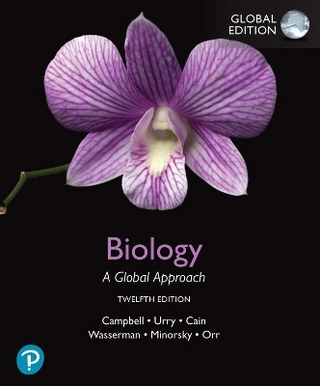
Nanobiotechnology II – More Concepts and Applications
Wiley-VCH Verlag GmbH (Hersteller)
978-3-527-61038-9 (ISBN)
- Keine Verlagsinformationen verfügbar
- Artikel merken
This second volume on a burgeoning field retains the proven concept of the spectacularly successful first one, extending and supplementing it. Individual sections are each dedicated to nanoparticles, nanostructures and patterns, nanodevices and machines, and nanoanalytics. Essential reading for an entire generation of scientists, this authoritative survey defines one of the most important new scientific fields to have emerged for many decades.
Chad A. Mirkin is the George B. Rathmann Professor of Chemistry and the Director of the Institute for Nanotechnology and the Center for Nanofabrication and Molecular Self-Assembly at Northwestern University in Evanston. Professor Mirkin holds a B.S. degree from Dickinson College (1986) and a Ph.D. degree in chemistry from The Pennsylvania State University (1989). He was a NSF Postdoctoral Fellow at the Massachusetts Institute of Technology before becoming a chemistry professor at Northwestern University in 1991. Professor Mirkin is known for his development of nanoparticle-based biodetection schemes and his invention of Dip-Pen Nanolithography. He is the founder of two companies, Nanosphere and NanoInk, which are commercializing nanotechnology applications in the life science and semiconductor industries. Christof M. Niemeyer is Professor of Chemistry at the University of Dortmund (Germany) where he holds the chair of Biological and Chemical Microstructuring. He studied chemistry at the University of Marburg and did his Ph.D. thesis at the Max-Planck-Institut fur Kohlenforschung in Mulheim/Ruhr under the supervision of Manfred Reetz. After a postdoctorate with Charles Cantor at the Center for Advanced Biotechnology in Boston (USA) he went back to Germany, where he worked with Dietmar Blohm at the University of Bremen to complete his habilitation before moving to Dortmund as a full Professor in 2002. He is interested in semisynthetic DNA-protein and DNA-nanoparticle conjugates and their applications in life sciences, catalysis and molecular nanotechnology.
Preface.List of Contributors.I Self-Assembly and Nanoparticles: Novel Principles.1 Self-Assembled Artificial Transmembrane Ion Channels (Mary S. Gin, Emily G. Schmidt, and Pinaki Talukdar).1.1 Overview.1.2 Methods.1.3 Outlook.References.2 Self-Assembling Nanostructures from Coiled-Coil Peptides (Maxim G. Ryadnov and Derek N. Woolfson).2.2 Methods and Examples.2.3 Conclusions and Perspectives.References.3 Synthesis and Assembly of Nanoparticles and Nanostructures Using Bio-Derived Templates (Erik Dujardin and Stephen Mann).3.1 Introduction: Elegant Complexity.3.2 Polysaccharides, Synthetic Peptides, and DNA.3.3 Proteins.3.4 Viruses.3.5 Microorganisms.3.6 Outlook.Acknowledgments.References.4 Proteins and Nanoparticles: Covalent and Noncovalent Conjugates (Rochelle R. Arvizo, Mrinmoy De, and Vincent M. Rotello).4.1 Overview.4.2 Methods.4.3 Outlook.References.5 Self-Assembling DNA Nanostructures for Patterned Molecular Assembly (Thomas H. LaBean, Kurt V. Gothelf, and John H. Reif).Abstract.5.1 Introduction.5.2 Overview of DNA Nanostructures.5.3 Three-Dimensional (3-D) DNA Nanostructures.5.4 Programmed Patterning of DNA Nanostructures.5.5 DNA-Programmed Assembly of Biomolecules.5.6 DNA-Programmed Assembly of Materials.5.7 Laboratory Methods.5.8 Conclusions.Acknowledgments.References.6 Biocatalytic Growth of Nanoparticles for Sensors and Circuitry (Ronan Baron, Bilha Willner, and Itamar Willner).6.1 Overview.6.2 Methods.6.3 Outlook.References.II Nanostructures for Analytics.7 Nanoparticles for Electrochemical Bioassays (Joseph Wang).7.1 Overview.7.2 Methods.7.3 Outlook.Acknowledgments.References.8 Luminescent Semiconductor Quantum Dots in Biology (Thomas Pons, Aaron R. Clapp, Igor L. Medintz, and Hedi Mattoussi).8.1 Overview.8.2 Methods.8.3 Future Outlook.Acknowledgments.References.9 Nanoscale Localized Surface Plasmon Resonance Biosensors (Katherine A. Willets, W. Paige Hall, Leif J. Sherry, Xiaoyu Zhang, Jing Zhao, and Richard P. Van Duyne).9.1 Overview.9.2 Methods.9.3 Outlook.Acknowledgments.References.10 Cantilever Array Sensors for Bioanalysis and Diagnostics (Hans Peter Lang, Martin Hegner, and Christoph Gerber).10.1 Overview.10.2 Methods.10.3 Outlook.Acknowledgments.References.11 Shear-Force-Controlled Scanning Ion Conductance Microscopy (Tilman E. Schaffer, Boris Anczykowski, Matthias Bocker, and Harald Fuchs).11.1 Overview.11.2 Methods.11.3 Outlook.Acknowledgments.References.12 Label-Free Nanowire and Nanotube Biomolecular Sensors for In-Vitro Diagnosis of Cancer and other Diseases (James R. Heath).12.1 Overview.12.2 Background.12.3 Methods and Current State of the Art.12.4 Outlook.Acknowledgments.References.13 Bionanoarrays (Rafael A. Vega, Khalid Salaita, Joseph J. Kakkassery, and Chad A. Mirkin).13.1 Overview.13.2 Methods.13.3 Protein Nanoarrays.13.4 DNA Nanoarrays.13.5 Virus Nanoarrays.13.6 Outlook.References.III Nanostructures for Medicinal Applications.14 Biological Barriers to Nanocarrier-Mediated Delivery of Therapeutic and Imaging Agents (Rudy Juliano).14.1 Overview: Nanocarriers for Delivery of Therapeutic and Imaging Agents.14.2 Basic Characteristics of the Vasculature and Mononuclear Phagocyte System.14.3 Cellular Targeting and Subcellular Delivery.14.4 Crafting NPs for Delivery: Lessons from Liposomes.14.5 Biodistribution of Liposomes, Dendrimers, and NPs.14.6 The Toxicology of Nanocarriers.14.7 Summary.References.15 Organic Nanoparticles: Adapting Emerging Techniques from the Electronics Industry for the Generation of Shape-Specific, Functionalized Carriers for Applications in Nanomedicine (Larken E. Euliss, Julie A. DuPont, and Joseph M. DeSimone).15.1 Overview.15.2 Methods.15.3 Outlook.References.16 Poly(amidoamine) Dendrimer-Based Multifunctional Nanoparticles (Thommey P. Thomas, Rameshwer Shukla, Istvan J. Majoros, Andrzej Myc, and James R. Baker, Jr.).16.1 Overview.16.2 Methods.16.3 Outlook.References.17 Nanoparticle Contrast Agents for Molecular Magnetic Resonance Imaging (Young-wook Jun, Jae-Hyun Lee, and Jinwoo Cheon).17.1 Introduction.17.2 NP-Assisted MRI.17.3 Outlook.Acknowledgments.References.18 Micro- and Nanoscale Control of Cellular Environment for Tissue Engineering (Ali Khademhosseini, Yibo Ling, Jeffrey M. Karp, and Robert Langer).18.1 Overview.18.2 Methods.18.3 Outlook.References.19 Diagnostic and Therapeutic Targeted Perfluorocarbon Nanoparticles (Patrick M. Winter, Shelton D. Caruthers, Gregory M. Lanza, and Samuel A. Wickline).19.1 Overview.19.2 Methods.19.3 Outlook.Acknowledgments.References.IV Nanomotors.20 Biological Nanomotors (Manfred Schliwa).20.1 Overview.20.2 The Architecture of the Motor Domain.20.3 Initial Events in Force Generation.20.4 Stepping, Hopping, and Slithering.20.5 Directionality.20.6 Forces.20.7 Motor Interactions.20.8 Outlook.Acknowledgments.References.21 Biologically Inspired Hybrid Nanodevices (David Wendell, Eric Dy, Jordan Patti, and Carlo D. Montemagno).21.1 Introduction.21.2 An Overview.21.3 The Protein Toolbox.21.4 Harvesting Energy.21.5 Methods.21.6 Outlook.Acknowledgments.References.Index.
| Verlagsort | Weinheim |
|---|---|
| Sprache | englisch |
| Maße | 170 x 240 mm |
| Gewicht | 1032 g |
| Themenwelt | Naturwissenschaften ► Biologie |
| Naturwissenschaften ► Chemie | |
| Technik ► Maschinenbau | |
| ISBN-10 | 3-527-61038-3 / 3527610383 |
| ISBN-13 | 978-3-527-61038-9 / 9783527610389 |
| Zustand | Neuware |
| Haben Sie eine Frage zum Produkt? |
aus dem Bereich

